
Zinpro Corporation Expert Details Key Water Testing and Management Considerations
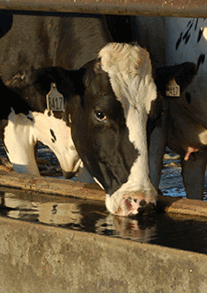 Never underestimate the importance of good drinking water to a dairy herd. Each cow consumes 30 to 50 gallons of water (115-190 liters) a day and water accounts for 87% of the milk she produces so providing clean, safe water is critical to maximizing her performance.
Never underestimate the importance of good drinking water to a dairy herd. Each cow consumes 30 to 50 gallons of water (115-190 liters) a day and water accounts for 87% of the milk she produces so providing clean, safe water is critical to maximizing her performance.
"Following air, water is the nutrient required in the largest quantity by dairy cattle," points out Dana Tomlinson, Ph.D., Research Nutritionist, Zinpro Corporation.
Common signs of poor water intake and quality in lactating dairy cows1 include depressed immune function (elevated somatic cell count), increased reproductive failure (conception failure, early embryonic death/abortions), and increased off-feed events and erratic eating patterns.
Any of the following symptoms could signal water-quality issues on a dairy:
- Health or performance concerns in cows
- Digestive upsets or scours in replacement animals
- Deteriorating health status of newly arrived heifers or dry cows
- Off-flavor, smell or color of drinking water
- Digestive upsets in humans drinking from the same water source
According to Tomlinson, water quantity or availability is equally as important as quality. Dairy cows spend 4 to 5 hours per day eating and only 20 to 30 minutes per day drinking water - making easy access to water a critical factor in meeting their hydration needs.
The dairy cow depends on readily available water to maintain blood volume, tissue function, rumen activity and proper flow of feed through the digestive tract, Tomlinson explains. He offers these management tips for optimizing water consumption:
- Provide direct access to clean water as cows exit the milking parlor
- Ensure adequate flow rate to maintain a minimum water depth of 3 inches (7.6 cm) in the trough
- Provide available trough space of 3.5 linear inches (9 linear cm) per cow
- Have at least two functioning waterers available per pen
- Provide access to water within 50 feet (15 m) of feed bunk
- Monitor stray voltage in water troughs and in the areas around them
Drinking water provides 60 to 80% of dry and lactating cows' water needs while feed provides most of the remaining water needed by these cows (Figure 1). Water requirements of cattle vary with level of production and environmental temperature (Figure 2).
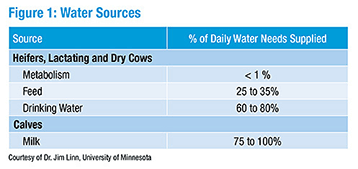
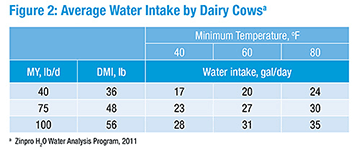
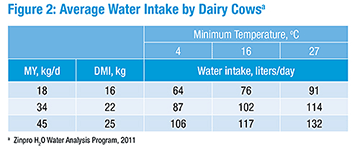
Assessing water quality
"When testing for water quality, total dissolved solids is one of the first things to evaluate," Tomlinson says. "This single test gives us a reading on the sum of all the dissolved/suspended inorganic matter present in the water sample."
High concentrations of dissolved solids such as sulfate, chloride, iron, manganese and nitrates are known to significantly affect animal performance. For more information about appropriate levels of nutrients (in water) for livestock, see Figure 3.
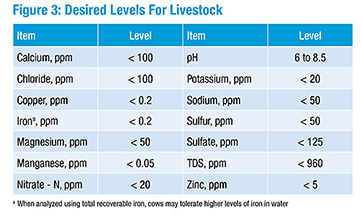
One critical component to analyze is the iron level. "Ferrous iron (Fe2+) dissolved in water is presumed to be highly absorbable with an estimated absorption rate approaching 100%," Tomlinson explains. "If the concentration is > 0.3 ppm in drinking water, this may cause problems for cows."
A total recoverable iron test performed by a diagnostic laboratory gives an accurate look at iron levels in water. Excess iron levels have wide-ranging consequences, including decreased palatability, increased oxidative stress contributing to immune dysfunction (which can lead to mastitis and metritis), and decreased absorption of copper, manganese and zinc from the diet.
Guidelines for water testing
Testing water quality requires an understanding of the contaminants, regarding both acceptable levels and their metabolic effects on dairy cows. Tomlinson suggests testing for:
- Total dissolved solids, pH, and hardness
- Excess minerals or compounds (such as sulfate, chloride, iron, manganese and nitrates)
- Coliform and bacterial counts
- Toxic compounds, including heavy metals, organophosphates, PCBs and hydrocarbons
According to Tomlinson, a water test is only as good as the sample and the laboratory testing it. He advises choosing a reputable lab with experience testing water for livestock and dairy operations to ensure valid results. Also, follow proper water-sampling procedures to ensure an accurate water analysis. Tomlinson recommends producers follow these steps for best results:
- Select a reputable testing laboratory
- Use sterile, plastic bottles supplied by the testing laboratory
- Return water samples to the lab within 24 hours of collection
- Sample the same water source as the animals drink
- Collect samples from the stream running into the watering trough, not directly from the pool of water
- Collect water samples from more than one pen, barn or water trough, in more than one location
- Let water run for several minutes before beginning to collect the sample
- Test water twice per year, in late summer and winter
Once the analysis is complete, decisions can be made on how any problems may be corrected. Common water treatments include disinfection, water softening, iron filtration, and reverse osmosis. See Figure 4 for additional information about common water problems and treatments.

Calves need good water, too
The quality of water used to make milk replacer is critical to a calf's health, and the availability of fresh water also affects nutrient intake and the calf's growth. In addition to milk replacer, research2 shows that calves should be offered free-choice water along with calf starter beginning at 4 days of age.
Research2 conducted by Donna Amaral-Phillips, Ph.D., Extension Professor of Animal Science, University of Kentucky, shows that depriving calves of fresh water decreases starter intake by 31% and weight gain by as much as 38% when compared to calves provided free-choice water.
Common signs of poor water intake and quality in calves1 include increased incidence of scours and digestive upsets, decreased immune competence, depressed daily gain and feed efficiency, and increased off-feed events and erratic eating behavior.
Zinpro H2O Water Analysis Program

The Zinpro H2O Water Analysis Program is a step-by-step tool that puts producers on the road to improved water quality. The program helps assess water quality by analyzing and comparing water samples to water quality standards, and it can help nutritionists, producers and veterinarians evaluate water analysis results, identify areas of concern and review signs of potential toxicosis.
For more information about the benefits of receiving a comprehensive water evaluation using the Zinpro H2O Water Analysis Program, contact your Zinpro representative or visit www.zinpro.com.
References:
1 R.S. Adams. Water intake and quality for dairy cattle. Penn State Univ. Ext. Serv.
2 Professional Dairy Producers of Wisconsin
6.25.2014